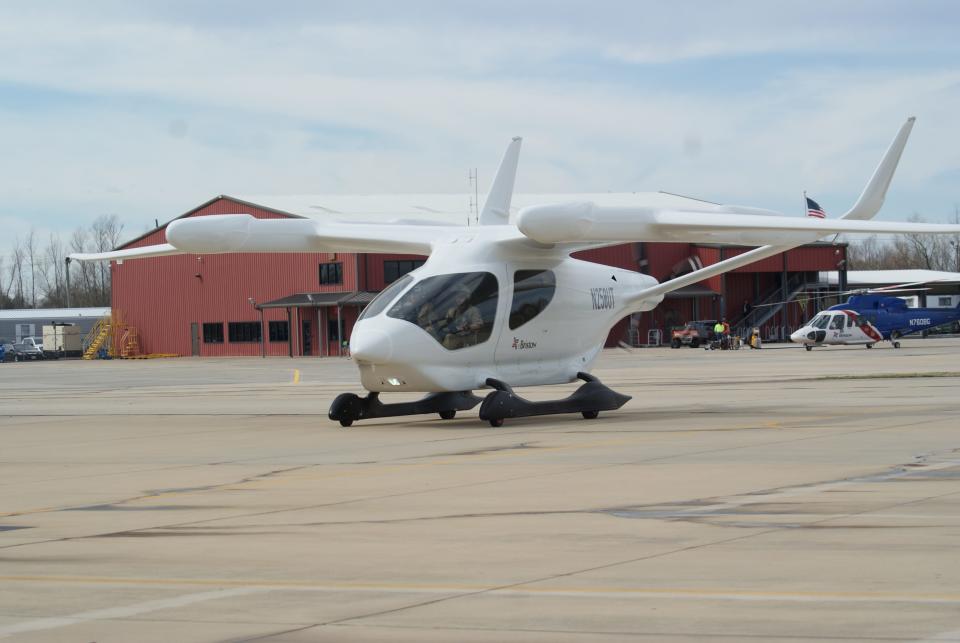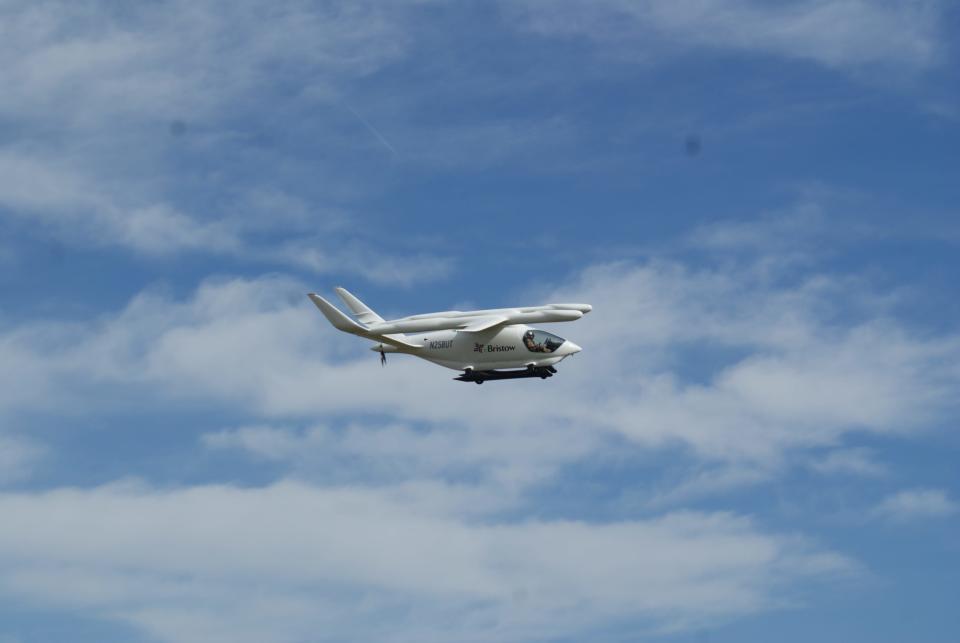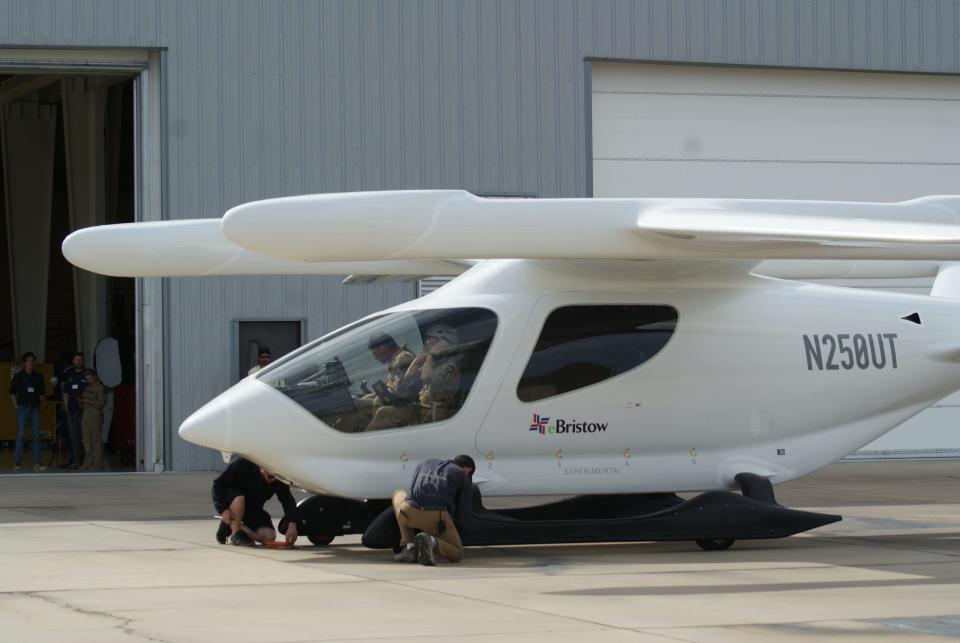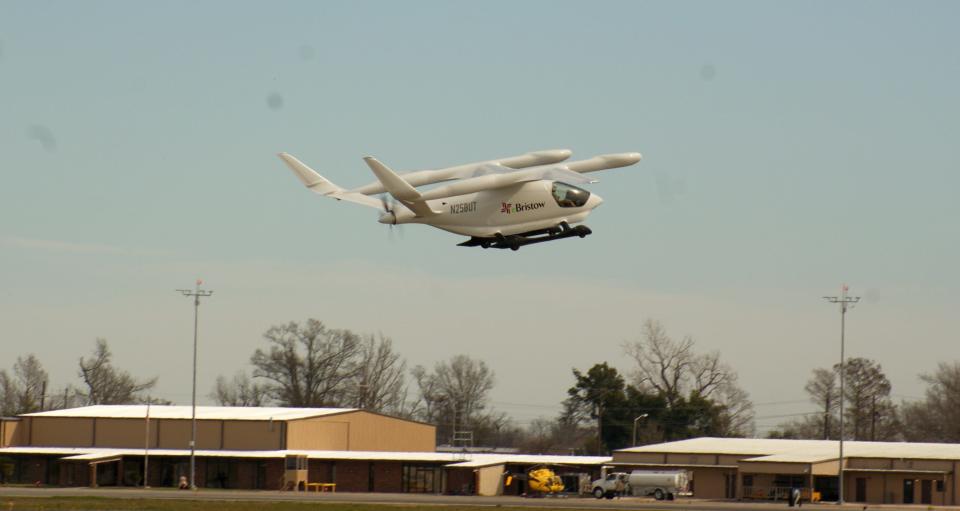Fully electric airplane shows off flight capabilities at Houma airbase
A fully electric plane took off, circled the Houma airbase twice and landed. It was quiet as it soared overhead.
"Once you're in flight and cruising and coming in to land, it's very quiet," Flight Test Engineer Emma Davis said. "When we come in to land, we are usually at idle, so for us that means we've had people come to us before and be like, 'Oh my gosh, we thought you had an engine failure, we didn't hear you come in.'"
Once the aircraft began to taxi in, the aircraft made the familiar sound as the propeller cut through the wind,
"It's loud on taxi, and it's loud on take off," Davis said. "Unfortunately, you'll never get rid of the physics of a loud prop."

Bristow demonstrated its new ALIA aircraft Wednesday at the Houma-Terrebonne Airbase. The fully electric plane currently has two prototypes: a conventional plane, eCTOL; and a hybrid plane-helicopter version, eVOTL. The hybrid was not on display, but the conventional version wowed the crowd of corporate representatives, as well as the local and state elected officials.
The aircraft, tail number N250 UT, was primarily white, with the propeller on its back end. It has two long booms protruding forward from the wings that serve no function. They are meant for the rotors of the VTOL version. The rotors were removed from this prototype, but the booms remain for the time being. The prototype's sister, tail number N251 UT, is still testing the VTOL capabilities.

At its furthest flight the ALIA, N250 UT, flew 336 nautical miles. On average it flies about 175 nautical miles, Davis said. She is based out of Burlington, Vt., and she travels in the copilot seat during most flights to collect data on how the prototype is doing.
"Typically, an average flight on five battery packs is 175 nautical miles," Davis said. "In flight tests, we carry reserves and whatnot."

The reserves are backup power that can be drawn on if an unforeseen need arises and for FAA requirements. A nautical mile is about 1.15 statute miles.
The ALIA has space for five large batteries that power the aircraft. Each battery weighs about 700 pounds, and the aircraft's total weight is 6,999 pounds when all batteries are in it. It was carrying less for the demonstration and weighed about 5,400 pounds. Its carry capacity is about 1,400 pounds, including the pilot, and has space for three standard-sized pallets in the back. It also can be outfitted to carry up to four passengers, in addition to the pilot.

Like electric cars, the 700-pound batteries are a limiting factor for the aircraft. Aircrafts always seek to shed pounds, but for more power, current battery technology demands larger batteries.
"There are limitations to how far we can fly just based off where battery technology is," Davis said. "I mean, half the aircraft weight right now is batteries."
Charging infrastructure is limited for electric aircrafts, but BETA Technologies, the creator of the ALIA, has overcome this by producing its own mobile charging unit that can be taken with the aircraft. On charging infrastructure, the aircraft takes about one hour to charge. It can take about three to five hours to fully charge on the mobile charger.
The ALIA, N250 UT, flies a little differently than a traditional aircraft. In a traditional aircraft there's a joystick, or collective, which functions similarly to a steering wheel. Pedals on the floor control the rudders. In the ALIA, the pedals are for braking, and the rudders are controlled by twisting the joystick.
Founder and CEO of BETA Technologies Kyle Clark said ALIA provides an 87% reduction in overhead costs compared to fuel-burning aircrafts. It currently is going through the Federal Aviation Administration certification process, but in the meantime, it's employed to move cargo for the United States Air Force. It's mostly moving MREs, toiletries and other items. It has more than 340 hours of flight time.
Bristow has committed to buying five of the ALIAs and has the option to purchase up to 100 more. Once the prototypes have proven themselves, the production of the additional ALIAs will be done at the BETA Technologies facility in Burlington, Vt. Bristow CEO Chris Bradshaw said the plan is to begin with cargo and scale up. He said the ALIA is unlikely to see use in flying workers out to offshore drilling rigs, but inspectors like the Bureau of Safety and Environmental Enforcement could see some use from the aircraft.
"Cargo first, then people over time," he said. "I think over time we probably will use an aircraft like the ALIA to do some of our missions over water. We've got some folks from BSEE that will be here today… BSEE is a mission where the ALIA would do very well, because again, you may be going 100 miles offshore, but you are only carrying two people."
This article originally appeared on The Courier: Bristow fully electric airplane demonstrates capability Houma airbase

